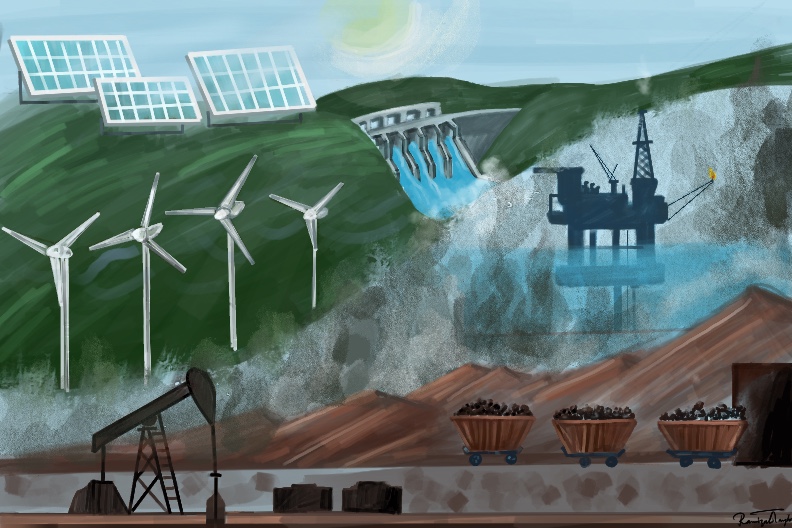From arrows to guns, from oil lamps to lightbulbs, from the telegraph to the telephone, collectively sending our farewell to outdated technology after the advent of new, more effective inventions is an inevitable stepping stone in human evolution. We currently sit on the precipice of one of these great shifts in our history, debating whether the new is worth saying goodbye to the old. In this case, making the decision quickly is crucial, as time is scarce.
Mankind has known about anthropogenic climate change since the 1970s. Since then, numerous top scientific organizations have advocated for the decline in fossil fuel use to limit warming to 2℃ by the end of the century. The 2015 Paris Climate Agreement attempted to codify this goal, stating the importance of reducing the production and use of fossil fuels and emphasizing the need to shift to renewable energy. While there are many competing interests and voices in this debate, one that should take precedence over most is the employees in these sectors.
As we stand on the brink of a major energy transition from fossil fuels to renewable sources, it’s crucial to objectively assess the opportunities in both green and fossil fuel jobs. This approach facilitates a smoother transition while addressing the needs and challenges faced by workers in both industries.
Current Job Numbers
The International Energy Agency estimates that in 2022, 67 million people were employed by the energy industry globally. Clean energy and fossil fuels employ 35 million and 32 million, respectively. China has the largest energy workforce today, accounting for nearly 30% of the global total. 60% of Chinese energy workers are employed in clean sectors, most notably manufacturing, which employs over three million people nationwide. Manufacturing success has led to Chinese dominance in the solar photovoltaic and electric vehicle battery sector with the country accounting for 80% of the world’s total. Regions like the Middle East, Indonesia, and India saw a general uptick in fossil fuel employment since 2019.¹
As for the United States, a 2022 report² by the US Department of Energy puts the number of clean energy jobs that meet the net-zero alignment definition at 3.1 million. A 114,000 job increase or a 3.9% growth, accounting for 40% of total national energy jobs. Around that same period, US fossil fuel jobs ranged between 908,422³ to 1.7 million.⁴
The data show that the number of clean energy jobs has either already exceeded or is about to surpass that of fossil fuel jobs.
Investment Trends
With energy demand increasing, total global energy investments are expected to exceed $3 trillion in 2024, with a major focus on renewables, accounting for $2 trillion. China leads the way, with an expected $675 billion investment in clean energy, making it the world’s largest share. Europe and the United States follow, pledging to invest $370 billion and $315 billion in clean energy, respectively. Developing economies are expected to invest $300 billion in renewable energy, surpassing previous figures.
As for fossil fuels investments, specifically global upstream oil and gas, are expected to increase by 7% in 2024, totaling $570 billion, worldwide. Middle Eastern and Asian national oil companies are predominantly responsible for the 2023–2024 growth in fossil fuel investments.⁵ As for the United States, most recent estimations put total fossil fuel investments at $200 billion, accounting for 19% of the global total.⁶
While both sectors are experiencing investment growth, it is clear that for every dollar spent on fossil fuels, two dollars are spent on renewable energy. Certain clean energy initiatives, like new offshore wind projects, receive three times the funding compared to investments in new coal and gas plants.⁷ These numbers clearly depict a collective global shift towards renewables and provide a crucial reference in this discussion about future energy employment.
Trajectory
Under current policies, it is anticipated that 8 to 10.3 million clean energy jobs will be created globally by 2030, while fossil fuel jobs are expected to decrease by 2.5 to 2.7 million.⁸ Under a NZE (Net Zero Emission) scenario, the net increase in energy job creation would be even greater at 17 million.
The electric vehicle industry is a leading job creator in the clean energy sector. It is predicted that a complete shift towards EVs could lead to the creation of over 2 million jobs by 2035.⁹
The primary sector within the energy industry that sees the greatest decline, both globally and in the US, is coal. Between 2008 and 2021, coal mining employment shrank by 59% in the East and 39% in the West.¹⁰ Total global coal loss is expected to be 1 million by 2050.¹¹ In the United States, the number of coal workers went from 125K in 1990 to under 50K in 2021.¹² Depicting a steady decline in coal and extraction.
Geographics
The United States is considered one of the world’s green job hotspots. States like Texas, North Dakota, and South Dakota lead in wind energy jobs, while California and Nevada lead in energy efficiency and solar jobs. Other states, such as Vermont and Delaware, have the highest per capita employment in energy efficiency.¹³ The United States is also a global leader in the electric vehicle industry, creating over 82,000 jobs just in 2022.¹⁴
Fossil fuel jobs in the US concentrate predominantly in the Appalachian states such as West Texas, New Mexico, and the Midwest.¹⁵ It is worth noting that due to the presence of fossil fuel-dependent industries, these regions are likely to experience “transition shock” as the United States starts investing heavily in renewables.¹⁶
Besides the United States, China is home to one of the largest concentrations of both clean jobs and fossil fuel jobs. Since 2006, the country has been collaborating with the ILO to create more green jobs.¹⁷
The European Union is also a leading employer in green jobs, with over a 25% job increase compared to a 7% increase in overall EU employment. Luxembourg, Estonia, and Bulgaria hold some of the highest shares of green employment.¹⁸
Health
Health is an overlooked consequence of working in the energy industry. Between green jobs and fossil fuel jobs, the latter is generally considered more dangerous. Fossil fuel jobs are considered the second most hazardous jobs in the United States, with 27.7 deaths per 100,000 people.¹⁹
Coal has been linked to an increased risk of heart disease, cancer, and respiratory illnesses. Coal mining regions have seen higher rates of circulatory, central nervous system, musculoskeletal, gastrointestinal, and urogenital illnesses, as well as an increase in birth defects.²⁰ A CDC report also states that oil and gas jobs reported the highest number of injuries to OSHA.²¹ It is estimated that a complete shift to renewable energy could prevent 1,300 worker deaths over the next decade.
While green jobs are generally considered safer, there are potential dangers associated with specific roles such as arc flashes, electric shock, falling, or thermal burns.²² However, such accidents or injuries can be avoided with the right training and equipment. Nuclear workers face a heightened risk of radiation exposure than the general public; therefore, such facilities have strong safety protocols and heightened security. Nuclear plant failures such as Chernobyl, Three Mile Island, and Fukushima are rare but do pose significant threats to the health and safety of workers and surrounding communities. However, evidence has overwhelmingly shown that nuclear power is a safe method of producing energy, more so than fossil fuels.²³
Salary
In the United States, energy workers earn a median hourly wage that is 34% higher than the overall national average.
Comparing salaries between green jobs and fossil fuel jobs reveals more complexity than previous comparison categories. This is because any claim made about either sector regarding compensation will have numerous exceptions, resulting in an oversimplification.
For example, when assessed as a whole, clean energy job salaries trail behind non-renewables, primarily due to the presence of strong unions in the fossil fuel industry.²⁴ However, there is the exception of nuclear, which usually offers higher wages and benefits than most fossil fuel jobs.
Therefore, it is important to approach the subject of wages with heightened nuance.
In the clean energy sector, nuclear workers earn an average hourly wage of $39.19, exceeding the national median by over 105%. Other clean sector jobs, such as biofuels and hydropower, can offer comparable salaries to fossil fuels. Green jobs in wind and solar typically have a median hourly income that is 35.6% and 27.9% greater than the national median, respectively. While wind and solar jobs are often regarded as “high paying,” they still fall behind oil and gas, and offer 15–30%²⁵ less compensation compared to nuclear jobs.
Nuclear, oil, and gas offer the highest wages within the entire energy industry. However, further disparities in wages are discovered in these three high-paying industries, depending on specific roles. Energy workers specializing in electric power generation, fuel, grid modernization, energy storage, and energy efficiency earn much higher wages compared to production helpers, construction laborers, and insulation workers.²⁶
The wage earned in the energy industry strongly depends on the specific field, job position, and skill level. To claim confidently that either green or fossil fuel jobs are more profitable would be a gross generalization.
Job Security
The debate about job security can be approached from multiple angles. Proponents of fossil fuel jobs may argue the presence of unions in the industry leads to higher wages, better benefits, and more job stability compared to green jobs. And while there is some evidence to confirm that statement, proponents of clean energy argue that green jobs are more future-proof²⁷ and less likely to experience mass layoffs, as evidenced by an upward trend in investments.
Furthermore, other studies have shown that some green jobs do offer benefits comparable to those of fossil fuels.
This is another aspect of this analysis that greatly depends on the specific field, job position, and skill level.
Why Green Jobs Might Win This Debate
At the moment, there doesn’t seem to be a perfect, obvious winner between green jobs and fossil fuel jobs as the pros and cons of each seem to vary based on industry, job title, and geographic region.
And while worker interest is highly important, we must address the collective, broader economic concerns as well. Chief among them is the economic consequences of climate change.
As it stands, the global economy is expected to lose between $1.7 trillion to $3.1 trillion per year by 2050. $2.8 trillion has been lost in extreme weather events over the past 20 years.²⁸ Climate change is already projected to reduce global income by 19% in 2049. That means GDP growth would have been 19% greater without climate change. If we achieve limiting average temperatures below 2°C, global income can stabilize to a 20% reduction in 2050. A worst-case scenario could lead to a 60% reduction in global income.
Poor countries, the ones least responsible for anthropogenic climate change, will face 61% greater income loss compared to rich countries.²⁹
Fair Transition Plans
There is a clear need for a shift in technology. Limiting GHG emissions is imperative. However, as we shift to another chapter in our history, we must not leave anyone behind. Governments need to invest in fossil fuel transition programs to help workers transition into emerging clean sectors. One study³⁰ estimated that a US coal transition program would cost $600 million and would develop a framework for supporting fossil fuel-dependent communities.
Transition programs should include financial support, retraining, and pension guarantees.
It is also important to understand that even if certain fossil workers possess the necessary skills to transfer to clean energy, their geographic location may not allow them to do so. Fossil fuel jobs and workers are concentrated in the Appalachian states and the Midwest, whereas most green jobs, such as solar, are located along the coast.
Due to this barrier, less than 2% of fossil fuel workers are likely to transition into green jobs. Therefore, targeted intervention must be incorporated in transition plans. Some plans suggest targeting 1 million green jobs to specific locations could lead to more successful transitions than creating 5 million green jobs without factoring in worker location.³¹
Furthermore, green infrastructure development plans need to include financial support for fossil fuel-dependent regions to offset losses due to layoffs or shutdowns. The 2022 Inflation Reduction Act, which partly aimed to invest in renewable technologies, overlooked fossil fuel-dependent communities, as over 124 of these counties were ineligible for economic support.³²
We need a plan that acknowledges the urgency of switching to renewables but also the responsibility towards fossil fuel workers undergoing labor transitions. The path forward must be one of innovation and inclusivity, forging a future where clean energy leads the way without leaving behind those who built the past.
Sources
- https://www.iea.org/reports/world-energy-employment-2023/executive-summary
- https://www.energy.gov/sites/default/files/2023-06/2023%20USEER%20EXEC%20SUMM-v2.pdf
- https://www.energy.gov/sites/default/files/2022-06/USEER%202022%20Fact%20Sheet.pdf
- https://www.brookings.edu/wp-content/uploads/2021/02/2021.02.22_BrookingsMetro_FossilFuel-MethodologyAppendix.pdf
- https://www.iea.org/news/investment-in-clean-energy-this-year-is-set-to-be-twice-the-amount-going-to-fossil-fuels
- https://www.iea.org/reports/world-energy-investment-2024/united-states
- https://www.iea.org/news/the-energy-world-is-set-to-change-significantly-by-2030-based-on-today-s-policy-settings-alone
- https://www.weforum.org/agenda/2022/03/the-clean-energy-employment-shift-by-2030/
- https://www.2035report.com/transportation/
- https://www.eia.gov/todayinenergy/detail.php?id=54579
- https://www.reuters.com/markets/coal-industry-faces-1-million-job-losses-global-energy-transition-research-2023-10-10/
- https://www.brookings.edu/articles/enable-a-just-transition-for-american-fossil-fuel-workers-through-federal-action/
- https://www.wri.org/insights/what-are-top-10-states-clean-energy-jobs
- https://www.nrdc.org/stories/demand-grows-electric-cars-does-market-green-jobs-ev-industry
- https://www.pitt.edu/pittwire/features-articles/green-jobs-fossil-fuel-workers
- https://www.fastcompany.com/91022799/this-map-shows-where-the-shift-to-clean-energy-will-most-affect-jobs
- https://www.climatescorecard.org/2020/09/china-leads-green-jobs-in-renewable-energy-sector/
- https://www.eea.europa.eu/en/analysis/indicators/employment-in-the-environmental-goods
- https://www.cbsnews.com/news/researchers-renewable-energy-jobs-are-safer/
- https://climatenexus.org/climate-issues/health/the-localized-health-impacts-of-fossil-fuels
- https://www.cdc.gov/mmwr/volumes/73/wr/mm7305a3.htm
- https://www.osha.gov/green-jobs/solar
- https://www.gisreportsonline.com/r/nuclear-energy-safe/
- https://www.vox.com/recode/22914487/clean-energy-fossil-fuels-salaries-unions
- https://www.iea.org/reports/world-energy-employment-2023/executive-summary
- https://static1.squarespace.com/static/5a98cf80ec4eb7c5cd928c61/t/606d1178a0ee8f1a53e66206/1617760641036/Wage+Report.pdf
- https://www.npr.org/2020/10/21/925504343/oil-jobs-are-big-risk-big-pay-green-energy-offers-stability-and-passion
- https://www.weforum.org/agenda/2023/10/climate-loss-and-damage-cost-16-million-per-hour
- https://apnews.com/article/climate-change-damage-economy-income-costly-3e21addee3fe328f38b771645e237ff9 *Note: GDP is projected to increase regardless of climate change. But without limiting average temperatures to 2 degrees Celsius, global income would be 20% less than what it could have been. Worst case scenario, it would be 60% less than what it could have been.
- https://journals.sagepub.com/doi/abs/10.1177/0160449X18787051
- https://www.fastcompany.com/90959192/the-biggest-barrier-to-getting-fossil-fuel-workers-into-green-jobs-not-skills-but-location
- https://www.fastcompany.com/91022799/this-map-shows-where-the-shift-to-clean-energy-will-most-affect-jobs



